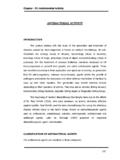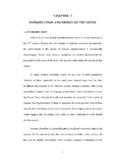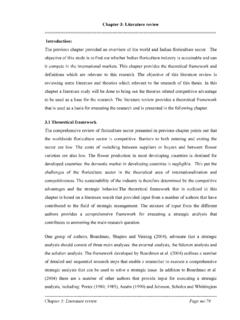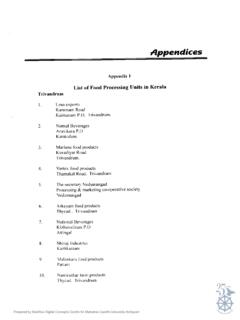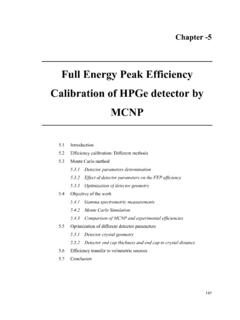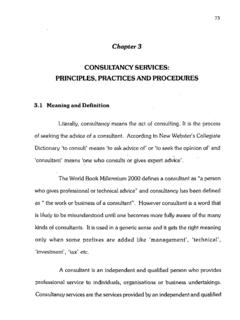Transcription of Method Development and validation for related …
1 Page 168 of 305 CHAPTER 4 Method Development and validation for related substances of Omeprazole in API and formulations by uplc . Introduction Omeprazole Formula : C17H19N3O3S CAS Number : 73590-58-6 Molecular Weight : Synonyms : 1H-Benzimidazole,5-methoxy-2-[[(4-methox y- 3,5-dimethyl- 2- pyridinyl)methyl]sulfinyl]; 5-Methoxy-2-(((4-methoxy- 3,5- dimethyl- 2-pyridyl)methyl)sulfinyl)benzimidazole; 2- (((3,5-Dimethyl-4- methoxy-2-pyridyl)methyl)sulfinyl)-5- methoxy- 1H-benzimidazole Melting point : 156 C Omeprazole having chemical nomenclature of (RS)-5-methoxy-2-((4-methoxy-3,5-dimethy lpyridin-2-yl) methylsulfinyl)-1H-benzo[d]imidazole belongs to a of class molecule called as proton pump inhibitors. Omeprazole was first approved in Sweden in 1988 for treatment of duodenal ulcer. It was approved in Canada and in the United States in 1989, for treatment of duodenal ulcer, gastric ulcers, reflux esophagitis, and Zollinger-Ellison syndrome1.
2 The mechanism of action is by means of suppression of hydrochloric acid secretion by specific inhibition of the H+/K+-ATPase in the gastric parietal cell thereby reduces the acidity. Page 169 of 305 Omeprazole is one of the most widely prescribed drugs internationally even if many advanced drugs in the same category are available thus large number of batches are manufactured perennially in a lot of pharmaceutical companies. So far very few methods have been reported for its determination of Assay by Chemical methods2,3. Some methods are also available in the literature for determinations of Omeprazole by HPLC4-11. The approximate runtime of the pharmacopeial methods12-14 ranges from 40-70 min. The time taken for the analysis significantly delays the batch to be released into the market.
3 Hence there is a need for the Development of fast and reliable Method for its routine analysis So far, to the best of our knowledge, no validated, stability indicating related substances Method by uplc has been reported for Omeprazole. Hence this Method was developed to quantitatively estimate Omeprazole and five of its impurities namely Impurity A, B, C, D and E by uplc .Moreover, this Method can be considered as first choice for analysis of Omeprazole related substances owing to its extremely short run time providing separation of 5 impurities without compromising on the selectivity of the Method . The resolution between the closest peaks in the Method is with a clear base to base separation. The proposed Method has been validated as per the International Conference on Harmonization (ICH) guidelines15 and United State Pharmacopoeia (USP).
4 The parameters considered for Method validation are specificity, precision, linearity, limit of detection, limit of quantification, forced degradation, and ruggedness. Active pharmaceutical ingredient standards and samples were procured as gift samples from Interlabs India pvt ltd, Hyderabad, India. Omez capsules manufactured by Dr. Reddy s Laboratories Limited, Hyderabad, India were procured commercially to use them as dosage form for the analysis purpose. The HPLC grade Acetonitrile and methanol and GR grade ortho phosphoric acid were purchased from HPLC Grade - E. Merck (India) Ltd., Mumbai, analytical grade Sodium dihydrogen phosphate was obtained from Spectrochem Pvt. Ltd., Mumbai (India),water was obtained from Millipore Plus water purification system, Bedford, MA, USA. Analytical grade hydrochloric acid, glacial acetic acid, sodium hydroxide pellets and 30% (v/v) hydrogen peroxide solution were obtained from Ranbaxy Fine Chemicals, New Delhi (India).
5 Page 170 of 305 Omeprazole Structure confirmation: 1. Thermal Analysis mg of the sample was weighed into an aluminum crucible of 25 L and placed into a DSC. The thermogram was recorded from 20 C to 250 C which is carried out under nitrogen atmosphere at 50mL/min, at 10 C /min. The thermogram exhibited sharp endotherm at C with an onset of C followed by decomposition as depicted below Figure DSC Thermogram for Omeprazole 2. UV Study: The Ultraviolet spectrum was recorded from 200 nm to 400 nm, with API concentration of in methanol. The spectrum showed two max at 207 and 301 nm. As seen below. Page 171 of 305 Figure UV spectrum for Omeprazole 3. FTIR Study The FTIR of spectrum of Omeprazole was recorded by preparation of pellet with KBr. The assignments are given in table No Table FTIR assignment table for Omeprazole Wave Number (cm-1) Assignment Vibration Mode 3242 -N-H Stretching 3059, 3006 Aromatic C-H Stretching 2985, 2904, 2802 Aliphatic C-H Stretching 1627, 1587, 1568 -C=C Stretching 1461, 1408, Aliphatic C-H Stretching 1204, 1016 Aryl alkyl ether C-O-C Stretching 1076 -S=O Stretching 822, 810 Aromatic C-H Stretching Page 172 of 305 Figure spectrum for Omeprazole 4.
6 NMR Study The 1H and 13C NMR spectra of Omeprazole were recorded in DMSO d6 at 400 MHz and 100 MHz respectively. The chemical shift values are reported on scale in ppm with respect to TMS ( ) and DMSO d6 ( ) as internal standard. Page 173 of 305 Table NMR Assignments of Omeprazole Position 1H (ppm) J(Hz)2 13C 1 NH S - 2 - - - 4 1H Br 5 - - - 6 1H d, 7 1H Br 8 - - - 9 - - - 10 Ha d, Hb d, - 11 - - - 13 1H S 14 - - - 15 - - - 16 - - - 17 3H S 18 3H S 19 3H S 20 3H S Page 174 of 305 Figure H1 NMR spectrum for Omeprazole Figure C13 NMR spectrum for Omeprazole Page 175 of 305 5. Mass Spectral study The mass spectrum of Omeprazole was recorded on 4000-Q trap LCMSMS system. The sample is introduced into the system through HPLC by bypassing the column.
7 The ESI +ve ionization spectrum of Omeprazole displayed a protonated molecular ion at m/z= 346 which corresponds to the molecular formula C17H17N3O3S. The fragmentation pattern was observed with product ion scan. The possible fragmentation pattern is shown below (Figure ). Figure Fragmentation pattern for Omeprazole Page 176 of 305 Figure Mass spectrum for Omeprazole Page 177 of 305 Impurities in Omeprazole: A. Following are the potential impurities in the manufacturing process of Omeprazole: 1. Impurity A: Chemical Name : 5-Methoxy-1H- benzimidazole-2-thiol Structure : 3. Impurity B Omeprazole Sulphone Impurity Chemical name :5-Methoxy-2-[[(4-methoxy-3,5-dimethylpy ridin-2-yl) methyl]sulphonyl]-1H-benzimidazole Structure: Page 178 of 305 2.
8 Impurity C: Omeprazole N-oxide Impurity Chemical name : 2-[(RS) [(3,5-dimethylpyridin-2-yl)methyl]sulfin yl]-5- methoxy-1H-benzimidazole. Structure: 4. Impurity D Desmethoxy Omeprazole Impurity Chemical name : 5-Methoxy-2-[[(3,5-dimethyl-2-pyridinyl) methyl] sulfinyl]-1H-benzimidazole. Structure : Page 179 of 305 5. Impurity E Omeprazole Sulphide Impurity Chemical name : 5-Methoxy-2-[[(4-methoxy-3,5-dimethylpyr idin-2-yl) ethyl]sulphanyl]-1H-benzimidazole Structure : Page 180 of 305 Method Development by uplc Objective: To develop an analytical Method for determination of related substances in a drug product capsules containing Omeprazole By uplc with the shortest possible run time.
9 The Method should be capable of Scope: This Method can be used for routine analysis in Quality control laboratories. This Method can also be applicable in Stability studies for determination of related substance and also degradation products in API and capsules containing Omeprazole. Chemicals and reagents: All the solvents used Acetonitrile, Methanol, Water were of HPLC grade. Selection of Mobile phase: Omeprazole is known to degrade in acidic pH. That is the reason why the formulations are enteric coated to be released in intestine where the pH is comparatively basic. Due to this reason, the mobile phases particularly the aqueous buffers need to be in basic side. The choice of buffers was made based on this reason. The trials were initiated with borax, where the splitting in peaks was observed; Ammonium acetate also had the same issue.
10 However disodium hydrogen phosphate showed improvement in peak shapes. The peak shapes and the separations could not be achieved to the best of requirement, thus sodium dihydrogen orthophosphate was selected with ph adjusted towards basic side. Mobile phase modifier, Triethylamine was added in order to improve the peak shapes. The organic phase was also selected to achieve better peak shapes and separations. Pure Acetonitrile did not separate all the peaks. Hence a mixture of Acetonitrile and methanol was selected. Page 181 of 305 Selection of Column: The selection of the column was comparatively a short process. The first column used was Kinetex XB-C-18 100A 50 x mm. By using this column, all the impurities did not elute within the run time and merging of peaks was observed, thus a second column HSS T3, 100* , m was selected where the separations improved significantly because of the better aqueous mobile phase compatibility.

